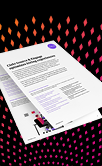Download available
How to avoid a head-on-culture crash
The future of work is a hot topic. To better understand how organizations can prepare for what may come, Cielo recently attended and sponsored CXO Innovation’s Chief Transformation Officer Summit. This event, which took place at The Shard in London, featured 18 speakers and 72 attendees – all senior leaders in transformation and customer experience (CX).
What leaders had to say
Discussions with the transformation leaders revealed that just 21% believe major transformation programs regularly prioritize people, communications, or people workstreams.
However, in a session, a staggering 51% of attendees said they’re struggling the most with the “people” element of transformations.

This delta perfectly illustrates the vital importance of considering people at every stage of strategic decision-making. Not to mention that company valuations are increasingly weighted toward intangible assets like reputation, brand culture, and people.
Common business scenarios that demonstrate talent’s crucial yet often overlooked role include:

Put simply: if you fail to prioritize the people aspect within change or transformation, business suffers.
To be ready for whatever the future brings, here are six tips transformation leaders have for C-suite leaders when it comes to talent:
Your employees are at the heart of any business transformation. Need help identifying and overcoming people-related challenges? Working closely with a strategic TA consultant will help you meet the unique needs to position your company for success – no matter how the future of work unfolds.
About the expert

Senior Vice President – Product Management, Cielo
LinkedIn connect